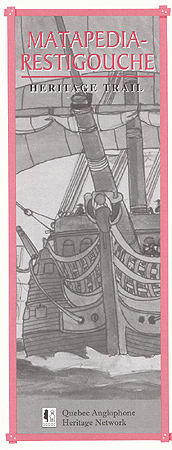
In the flash of cannon and musket fire the waters of the Restigouche River were made a blazing stage for a fateful battle.
The tide of war had turned in Britain’s favour in the summer of 1760. French forces, beaten at Quebec City, desperately awaited reinforcements. All hope lay with a small convoy of supply ships, now waylaid in the Restigouche basin.
From prehistoric times, Micmac people had journeyed overland between the tidewater at Chaleur Bay and the St. Lawrence, along trails that followed the Matapedia River valley. To guard this vital route, France had built a fort on the banks of the Restigouche just west of Pointe-à-la Croix (Cross Point). As British warships nosed their way upstream toward it, the commander of the doomed convoy scuttled his vessels to block the channel.
Today, artifacts from the sunken French frigate Le Machault are on display at the Battle of the Restigouche National Historic Site.
The fall of New France marked the beginning of a new era for the Gaspé. Its fish, timber and fur resources lured Scottish traders George Walker and Hugh Baillie to the Restigouche in 1768; English merchants John and Henry Shoolbred soon followed. Then, in the aftermath of the American Revolution, many New England Loyalists came north along the St. John River from the Bay of Fundy and cleared land. They were later joined by waves of Irish, Acadian and English homesteaders.
Descendants of these early Quebec settlers still carry on a way of life based on fishing and logging.
HOW TO GET THERE
From Quebec City, follow the St. Lawrence River east on Autoroute 20 and Route 132, turning south at Mont-Joli. This tour leads to historic sites and points of interest in the Matapedia and Restigouche valleys along a stretch of Route 132 between Causapscal and Miguasha at the head of Chaleur Bay.
 MATAMAJAW SALMON CLUB
MATAMAJAW SALMON CLUB
Historic Site, Causapscal
A stopover on the historic Kempt Road between Métis and the Restigouche, the junction of the Causapscal (pronounced Coz-Opsicle by local English speakers) and Matapedia rivers was known to early travellers simply as Les Fourches, one of a handful of posts spread out along the 97-mile-long road, which was first opened in 1833. Here a sprawling, century-old fishing resort has been transformed into a showcase for the valley’s salmon-angling heritage.
Although this community is entirely French-speaking today, one of Causapscal’s early pioneers was Jonathan Noble, a New England loyalist who came to Quebec by way of New Brunswick following the Great Miramichi Fire. It’s recorded that he cleared land here in the early 1800s and was later a keeper of the local post. His homestead is said to have been where Causapscal’s beautiful neo-gothic stone Catholic church (1910) stands today.
The Matamajaw Salmon Club, part of a private estate established around 1870 by Montreal financier and railway baron George Stephen, belonged for decades to a 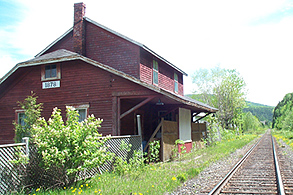 small group of wealthy businessmen. In operation from the early 1900s until the 1960s, the main lodge perches over some of Quebec’s finest Atlantic salmon water. Today a specially designed observation pool offers sightseers close-up views of young fish.
small group of wealthy businessmen. In operation from the early 1900s until the 1960s, the main lodge perches over some of Quebec’s finest Atlantic salmon water. Today a specially designed observation pool offers sightseers close-up views of young fish.
Scrupulously maintained and authentically furnished, the lodge offers a whiff of the fusty grandeur with which men of means, commanding servants and private rail-cars, indulged their passion.
Matamajaw Historic Site
53C, rue St-Jacques
(418) 756-3344
ROUTHIERVILLE
Another of the early Kempt Road posts, this enchanting railway whistle-stop was known to early travellers by its Micmac name, Assametquagan. Its current name honours the memory of a former station master, Alphonse Routhier.
Thomas Evans is recorded as Assametquagan's first settler but the hamlet’s modern origins lie with the Intercolonial Railway, built between 1867 and 1876 to link the Maritime colonies with the rest of Canada.
Rail construction opened the Matapedia to further development by bringing thousands of workers into the valley. Trains also made it possible to establish the region’s celebrated Atlantic salmon sport-fishery.
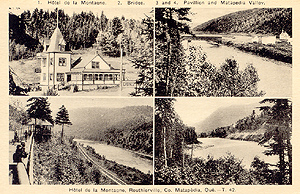 A good view of the river and Routhierville’s 79-metre-long covered bridge, built in 1931, can be found in a rest area just off the highway. Note the red wooden station, built in 1878, looking somewhat forlorn beside the tracks.
A good view of the river and Routhierville’s 79-metre-long covered bridge, built in 1931, can be found in a rest area just off the highway. Note the red wooden station, built in 1878, looking somewhat forlorn beside the tracks.
MANN SETTLEMENT
While the names of many settlements in the old Matapedia and Restigouche townships have been changed or forgotten -- Sillarsville, Millstream and Rustico, to name a few -- Mann Settlement still honours the memory of a prominent Gaspé pioneer clan, descendants of New York Loyalist Col. Isaac Mann. Generations of Irvine and Lyons families have lived here since the 1880s. The Mann Settlement Baptist Church is a well-known landmark standing beside a pioneer cemetery.
MATAPEDIA (Pop. 800)
This cozy, bilingual village at the fork of the Matapedia and Ristigouche rivers is famous for its salmon angling. Locals have earned their livelihood in luxury private fishing camps for generations, working as guides, cooks, caretakers and wardens. The largest and most famous of these, the Restigouche Salmon Club, is also Canada’s oldest fishing club.
Founded in 1880, the club’s main camp (8 rue Perron East) sits on land purchased from Matapedia pioneer Daniel Fraser, a Nova Scotia-born merchant-trader who, together with his Scottish wife Jean Ritchie, ran a farming, fishing, lumbering and trapping enterprise here in the 1830s. Grog Island camp on Riverside Drive was owned for many years by the celebrated American newspaper publisher Joseph Pulitzer.
New England Loyalists of Scottish descent were Matapedia’s first non-native settlers. Their legacy lives on in common local names: Adams, Bell, McDavid, Moores, Mowat, Wheeler, to mention a few. Runnymede, a wee farming settlement seven miles from Matapedia, at the end of Riverside Drive, marks the site where the first colony of Scots loyalists settled about 1807. Their descendants still work the land.
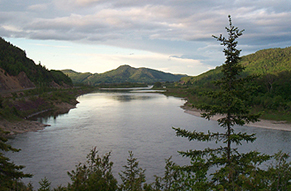 A number of tiny outlying communities sprang up in the 1800s. Most have vanished, though a lonely Baptist church marks the site of Moores Settlement on Riverside Drive; and in DeeSide, named for loyalist pioneer John Mowat’s ancestral home on Scotland’s River Dee, a pioneer schoolhouse still stands.
A number of tiny outlying communities sprang up in the 1800s. Most have vanished, though a lonely Baptist church marks the site of Moores Settlement on Riverside Drive; and in DeeSide, named for loyalist pioneer John Mowat’s ancestral home on Scotland’s River Dee, a pioneer schoolhouse still stands.
Matapedia is also home to descendants of Irish families who began to settle in the region around 1850. The unique Gothic-style white-wooden Catholic Church (1902) overlooking the rivers’ union pays apt tribute to their forebears who, in 1870, joined with French neighbours to found the Parish of St. Lawrence of Matapédia.
KEMPT ROAD HISTORY CENTRE
The forging of a link between Chaleur Bay and the Metis Seigniory on the St. Lawrence River was a feat of such great importance for Gaspé settlers that local heritage enthusiasts still celebrate it with a little summer museum and handicrafts boutique at the historic road¹s southern entrance.
Border frictions between the United States and Britain lingered for many years following the American Revolution and the War of 1812-1814. The threat of renewed hostilities prompted calls for establishing new lines of communication between the St. Lawrence River and the Atlantic seaboard. Restigouche pioneer Isaac Mann knew the ancient Micmac trails and was an early advocate of the overland route from Restigouche to Metis.
Promoted by Canada’s governor-general, James Kempt, this early military road was surveyed and cleared between 1830 and 1833.
Housed in the St. John United Church building west of the Micmac village of Listigouch, the interpretation centre gives details about the road’s history in a display featuring old survey maps and memorabilia dating to the early 1800s.
Interpretation Centre
6 chemin Kempt, Ristigouche-Partie-Sud-Est
(418) 788-5769
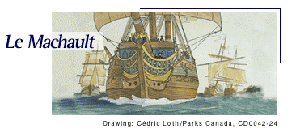 BATTLE OF THE RESTIGOUCHE
BATTLE OF THE RESTIGOUCHE
National Historic Site
Operated by Parks Canada, this fascinating museum commemorates the site of the final naval battle France and England fought for control of Canada, a pivotal episode of the Seven Years’ War.
During the summer of 1760 a squadron of three British warships sailed into the river pursuing a convoy of French supply vessels, part of a relief expedition sent from Bordeaux in hopes of retaking Quebec City. The smaller French ships were no match for the British men-of-war and on July 8, 1760 after many days of combat, the Royal Navy claimed victory. Defeat at Ristigouche sealed New France¹s fate. Cut off from help, France’s last Canadian stronghold, Montreal, surrendered to Britain the following September.
The Ristigouche exhibit features a variety of relics salvaged from the sunken French frigate, Le Machault, parts of which were recovered by divers in the early 1970s. Visitors will marvel at the ship’s massive oak rudder and a partially rebuilt section of its hull. An audiovisual display gives details about the battle and its historical significance for Quebec and North America.
Interpretation Centre
Tel: (418) 788-5676
Toll free 1 (800) 463-6769
Website: http://parcscanada.gc.ca/ristigouche
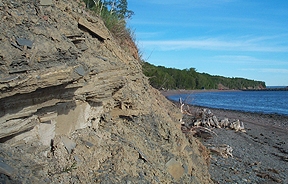 MIGUASHA PARK
MIGUASHA PARK
United Nations World Heritage Site
Hundreds of millions of years ago when continental North America was part of northern Europe and lay closer to the earth’s equator, the waters of Chaleur Bay at the mouth of the Restigouche formed a shallow tropical lagoon. Many ancient plants and sea creatures lived here and when they died, some left their mark in the muddy river bottom. This mud hardened into rock over time, leaving scientists a unique fossil record of the past.
Since their discovery on the Miguasha cliffs near the village of Nouvelle in the late 1880s, the fossil beds have revealed much about how life evolved on our planet. These beds contain some of the world’s best-preserved specimens of ancient lobe-finned fishes, for instance, ancestors of the first four-legged animals. Plaques along a cliffside walking trail tell about this evolution.
Part laboratory, part natural history museum, the park’s indoor exhibit admirably illustrates the methods of paleontology. Declared a world heritage site in 1999, Miguasha Park is operated by Quebec’s provincial parks authority, SEPAQ.
Parc Miguasha
270, route Miguasha Ouest
Nouvelle, Quebec
Telephone: (418) 794-2475
![]()
![]() This guide is presented by the Quebec Anglophone Heritage Network. The Heritage Trails series is made possible by grants from the Department of Canadian Heritage and Economic Development Canada. Space constraints preclude mention of all possible sites.
This guide is presented by the Quebec Anglophone Heritage Network. The Heritage Trails series is made possible by grants from the Department of Canadian Heritage and Economic Development Canada. Space constraints preclude mention of all possible sites.
Thanks to Gaspé of Yesterday author Dr. Ken Annett and Gertrude Fitzgerald for their help.